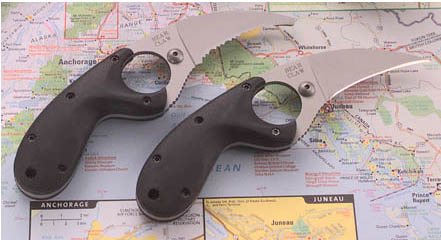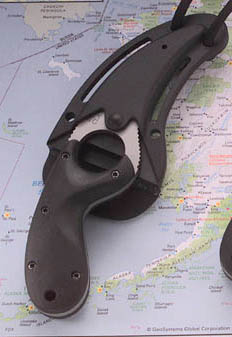Advertised as a river knife in a local outdoors outfitting store, I was
immediately drawn to the familiar shape of the so-called Bear Claw.
Designed by an Alaskan knife maker, it did resemble its namesake
and most likely those of some great Alaskan Grizzly. But that wasn't
what I saw when I looked at it. To my eye, it was clearly an
Indonesian karambit in design. And I wanted it.
 With a shaped handle that fit the palm better
upside down in icepick grip, it left no doubt in my mind that this
was more of a weapon than an emergency tool. OK,
so there are two versions of the Bear Claw -
one with a non-piercing stub nose and serrated edge good for cutting webbing
and tangled rope. But the other, with a straight edge and wicked point,
looks like anything but a tool. It is a fighting cockspur for a human hand
(its designer does in fact admit it was originally
a defensive weapon made for his wife). And I wanted it.
With a shaped handle that fit the palm better
upside down in icepick grip, it left no doubt in my mind that this
was more of a weapon than an emergency tool. OK,
so there are two versions of the Bear Claw -
one with a non-piercing stub nose and serrated edge good for cutting webbing
and tangled rope. But the other, with a straight edge and wicked point,
looks like anything but a tool. It is a fighting cockspur for a human hand
(its designer does in fact admit it was originally
a defensive weapon made for his wife). And I wanted it.
The Zytel sheath with a nub lock is a good design overall. It allows
the knife to be safely hung around the neck by a lanyard for fast access, or
slung any number of other places thanks to additional holes, screws and
strong clasp. My CRKT Stiff K.I.S.S. (generously given
to me by Tuhon McGrath) has a similar sheath and lock and has served me well -
used as a river knife on my last kayaking expedition and taped securely to
my PFD, I'd needed
to execute a rapid draw and thrust - the sheath released the
knife perfectly and my grip was correctly set on impact. Having lost several
other river knives on previous trips, I was gratified
to find that it held the knife safely all the rest of the time.
However I
found that with the much shorter hilt on the Bear Claw, it was harder
to pull quickly, especially into the inverted grip. The finger couldn't seek
the hole properly; it hit the back of the sheath before the blade cleared it,
forcing me to rely more on pressure outward from my thumb to pull it free.

|
But once in the hand, it is a guilty pleasure to wield. And a seductive
(if somewhat risky) invitation to practice traditional Hari Mau
techniques for karambit. I definitely wanted it.
Time will tell if this is truly a good river knife and whether the
steel will hold its edge (and that rather delicate looking tip). And
purists will point out that the hole in the
hilt of a karambit is usually at the other end, away from the blade.
But given
the general scarcity of good karambits on the market, I'm happy to
say that I got what I wanted.
|
Loki Jorgenson
FMA Database Editor